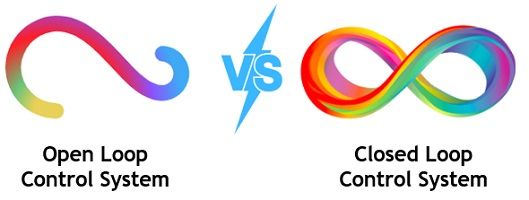 Open loop and closed loop control systems are the two control systems. The open loop control system is one where the control action is independent of the output produced by the physical system. It means that the output of the open loop control system does not perform any changes to the control action.
Open loop and closed loop control systems are the two control systems. The open loop control system is one where the control action is independent of the output produced by the physical system. It means that the output of the open loop control system does not perform any changes to the control action.
However, the closed loop control system is one where the control action depends on the output produced by the physical system. It means the output of the closed loop control system performs changes to the control action.
The accuracy of the open loop control system depends on the experience of the user. On the other hand, the closed loop system is accurate even in the case of non-linearity. Before discussing this further, let’s first understand a control system.
What is a Control System?
In a control system, the output quantity that the control system generates can be controlled by varying the input quantity. A control system has physical components configured to alter, regulate or command another physical system through control actions so that it exhibits desired characteristics or behaviour.
We can classify the control system into two types based on system configuration.
- Open Loop Control System
- Closed Loop Control System
In this section, we will identify differences between open loop and closed loop control systems.
Content: Open Loop Vs Closed Loop Control System
- Comparison Chart
- What is Open Loop Control System?
- Example of Open Loop Control System
- What is Closed Loop Control System?
- Example of Closed Loop Control System
- Key Differences
- Conclusion
Comparison Chart
| Basis for Comparison | Open Loop Control System | Closed Loop Control System |
|---|---|---|
| Control action | The control action is independent of the output produced. | The control action is dependent on the output produced. |
| Changes | The output of the control system does not change the control action. | The output of the control system changes the control action. |
| Feedback Path | In an open loop control system, no feedback path is provided. | In closed loop control system, a feedback path is provided. |
| Also Referred | Also referred to as a non-feedback control system or manual control system. | Also referred to as a feedback control system or automatic control system. |
| Physical Components | Controller and plant | Controller, plant, feedback mechanism, error detector |
| Correction | Changes in the output due to external disturbance are corrected manually. | Changes in the output due to external disturbance are corrected automatically. |
| Configuration | Configuration of open loop control system is simple. | Configuration of closed loop control system is complex. |
| Response | The open loop control system responds faster. | The closed loop control system responds slower. |
| Handle Disturbance | They are not equipped to handle disturbance. | They are not equipped to handle disturbance. |
| Accuracy | Open loop control system is inaccurate. | Closed loop control system is accurate. |
| Reliablility | Less reliable | More reliable |
| Cost | Low cost | Costly |
What is Open Loop Control System?
The control system accepts input, processes it and generates an output. Internally the open loop control system comprises two physical components a controller and a plant. The controller is responsible for controlling the amount of input, and the controlled input is then provided to the plant.
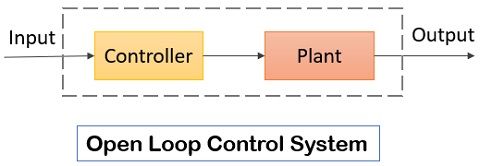
The plant component processes the controlled input and generates the corresponding output. In the open loop control system, the control action, i.e., the controlled amount of input that it provides to the plant, is independent of the generated output.
In simple words, we don’t have any feedback mechanism here that would tell the controller how to vary the input in order to get the desired output. Thus, in open loop control system, the accuracy totally depends on its user experience.
Let’s understand the open loop control system with the help of an example.
Example of Open Loop Control System
An immersion rod is the best example of an open loop control system. The rod accepts the electric charge as input and heats the water as an output. Here, even if the water is heated to a desired temperature, no feedback mechanism would tell the rod controller to stop or vary the amount of charge it supplies.
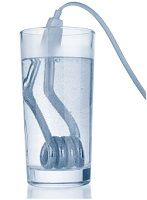
Thus, the rod keeps on heating the water more and more. The user has to manually switch off the power to stop it from heating more.
Advantages
- The open loop control system has a simple configuration, making its construction easy.
- They are inexpensive.
- There are few physical components to process input, so the open loop control systems respond faster.
Disadvantages
- The changes in the output due to external disturbance are not corrected automatically.
- Thus, they need to be more accurate.
What is Closed Loop Control System?
The physical components of the closed loop control system involve a controller, plant, feedback or a sensor and an error detection component. Initially, the input, i.e., reference input, is provided to the controller. The controller controls the amount of input and forwards it to the plant. Further, the plant processes the controlled input and generates the output.
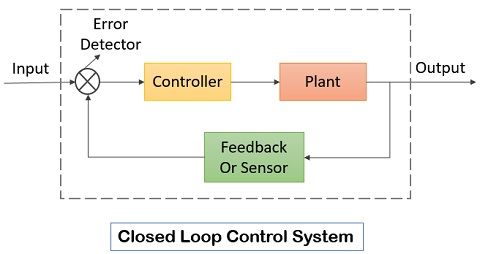
As soon as the first output is generated, the feedback element samples the output and convert the sampled output to the signal of the same type as the reference signal. Now this feedback signal is fed to the error detector. The error detector identifies the difference between the reference signal and the feedback signal and accordingly generates the error signal and provides it to the controller.
The controller modifies the error signal to generate the control action. The plant then processes the control action to correct its output.
The closed loop control signal is less affected by the external disturbance, and hence they are accurate.
Example of Closed Loop Control System
An air conditioner is the best example of closed loop control system. The air conditioner’s output is to maintain the desired temperature in the room. So it continuously monitors the surrounding temperature and regulates the compressor to maintain the desired temperature in the room by providing feedback to the controller.
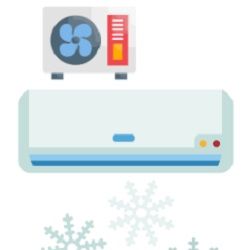
Advantage
- The feedback mechanism automatically corrects the output.
- Thus, they are accurate
- It is equipped to handle external disturbances.
Disadvantages
- With more physical components, the configuration of a closed loop control system is complex.
- They are costly.
- The response is slow.
Key Differences Between Open Loop and Closed Loop Control Systems
- Open loop control system is one where the control actions are independent of the output produced. However, the closed loop control system is one where the control action depends on the output produced.
- The output produced by the open loop system does not change the control actions. The output produced by the close loop system changes the control action.
- In the open loop control system, no feedback path is provided; thus, there is no change in the control action. In a closed loop control system, a feedback path is provided that reflects the changes in the control action.
- We often refer to open loop control systems as non-feedback or manual control systems. On the other hand, we often refer to closed loop control systems as feedback control systems or automatic control systems.
- An open loop control system’s physical components are a controller and a plant. However, the physical component used in closed loop control systems is a controller, plant, feedback element and error detector.
- Changes reflecting in the output of the open loop system due to external disturbance has to be corrected manually. On the contrary, the changes reflected in the output of a closed loop system due to external disturbance are corrected automatically, and it does not require human intervention.
- Configuration of the physical components of the open loop system is quite simple. Conversely, the configuration of the physical components of the closed loop system is complex.
- Open loop control system responds to the input faster as there are few physical components to process the input. On the contrary, the closed loop control system responds comparatively slower as the number of components is more than the open loop control system.
- Open loop system is not equipped to handle external disturbance. On the other hand, the closed loop system is equipped to handle the external disturbance.
- As there is no automatic correction mechanism open loop systems are inaccurate. However, there is an automatic correction mechanism that makes the closed loop control system accurate.
- Open loop systems are less reliable than the closed loop control system.
- Closed loop control system is costly as compared to open loop control system.
Conclusion
So, these are the differences between open loop control system and closed loop control system. Most electronic devices use closed loop control system as they correct themselves automatically and provides accuracy.
Leave a Reply